Estudo comparativo da ovariohisterectomia felina com incisao no ...
Estudo comparativo da ovariohisterectomia felina com incisao no ...
Estudo comparativo da ovariohisterectomia felina com incisao no ...
You also want an ePaper? Increase the reach of your titles
YUMPU automatically turns print PDFs into web optimized ePapers that Google loves.
Tabela 3 - Tempos médios, em segundos, <strong>da</strong> duração total <strong>da</strong>s cirurgias realiza<strong>da</strong>s por VF2 e VM2, e<br />
<strong>da</strong> duração de ca<strong>da</strong> parte <strong>da</strong>s cirurgias.<br />
Parte <strong>da</strong><br />
cirurgia<br />
VF2<br />
Média Desvio<br />
Padrão<br />
58<br />
VM2<br />
Média Desvio<br />
Padrão<br />
Teste U de<br />
Mann-<br />
Whitney<br />
T1 177 17 211 58 p= 0,456<br />
T2 217 9 142 63 p= 0,053<br />
T3 846 96 550 231 p= 0,053<br />
T4 465 106 366 210 p= 0,456<br />
T5 350 37 478 11 p= 0,025<br />
Tempo<br />
total<br />
2054 210 1746 460 p= 0,456<br />
Relativamente aos tempos parciais, apenas T1 e T5, que correspondem respectivamente à<br />
abertura e ao encerramento <strong>da</strong> cavi<strong>da</strong>de abdominal, apresentaram valores inferiores na<br />
abor<strong>da</strong>gem pelo flanco. As restantes etapas cirúrgicas foram mais demora<strong>da</strong>s nesta<br />
abor<strong>da</strong>gem.<br />
Em T1, o tempo médio±dp <strong>da</strong> aproximação pelo flanco foi de 177±17 segundos e na linha<br />
média de 211±58 segundos (p= 0,456). Em T2, T3 e T4 a abor<strong>da</strong>gem pela linha média foi<br />
mais rápi<strong>da</strong>, embora a diferença tenha sido pouco significativa (T2: p= 0,053, T3: p= 0,053,<br />
T4: p= 0,456).<br />
Para ligar e seccionar os pedículos (T3), VF2 refere ser mais difícil exteriorizar e ligar o<br />
pedículo ovárico direito, devido à maior dificul<strong>da</strong>de de acesso a esse ovário. Nesta fase, a<br />
abor<strong>da</strong>gem pelo flanco foi mais demora<strong>da</strong>, <strong>com</strong> um tempo médio±dp de 846±96 segundos,<br />
<strong>com</strong>parativamente à linha média que apresentou um tempo médio±dp de 550±231<br />
segundos.<br />
A única fase que se mostrou uma diferença significativa (p= 0,025) na duração de tempo foi<br />
T5, <strong>com</strong> um tempo médio±dp de 350±37 segundos na aproximação pelo flanco e 478±11<br />
segundos pela linha média.<br />
Na análise do tamanho final <strong>da</strong> incisão, <strong>com</strong> os <strong>da</strong>dos correspondentes às cirurgias dos MV<br />
me<strong>no</strong>s experientes, a incisão <strong>no</strong> flanco foi significativamente mais pequena (p= 0,025), <strong>com</strong><br />
um tamanho médio±dp de 2,8±0,3 cm, <strong>com</strong>parativamente à incisão na linha média, 4,14±0,5<br />
cm. Utilizando apenas <strong>da</strong>dos relativos aos MV mais experientes, também a aproximação<br />
pelo flanco apresentou um tamanho médio±dp de incisão mais curto, 1,4±0,2 cm, do que o<br />
<strong>da</strong> linha média, 2,7±0,3 cm. No entanto, a significância estatística foi maior (p= 0,001).


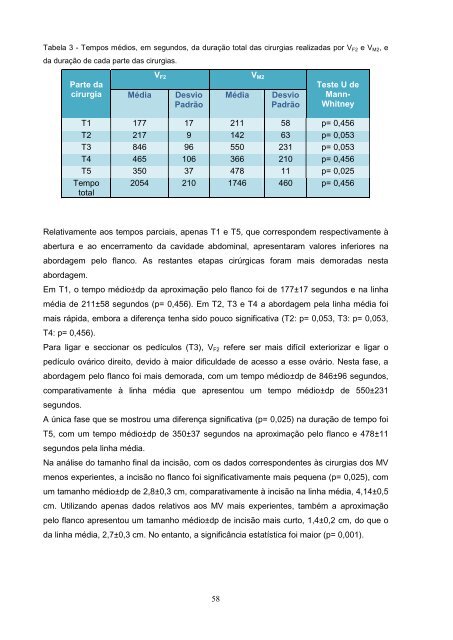
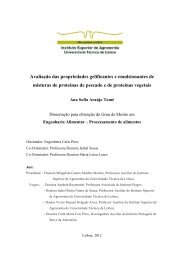
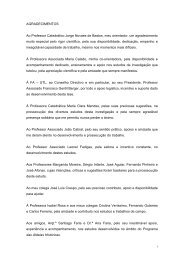


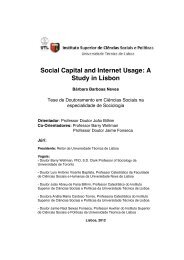
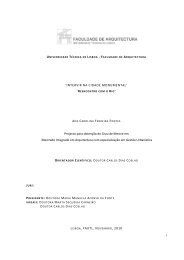
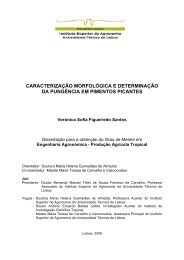

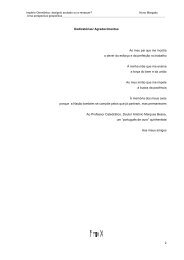

![Tese - Es..[1].pdf - UTL Repository - Universidade Técnica de Lisboa](https://img.yumpu.com/25707135/1/184x260/tese-es1pdf-utl-repository-universidade-taccnica-de-lisboa.jpg?quality=85)


